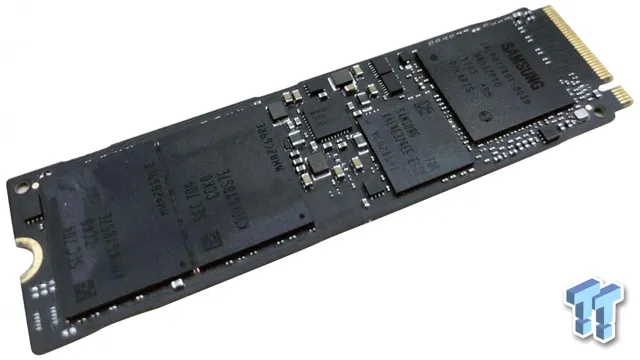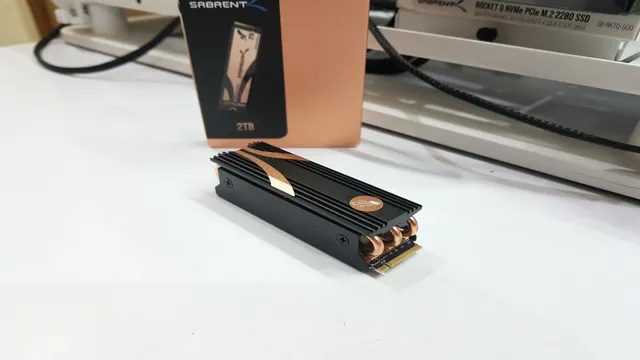M.2 drives have become increasingly popular in recent years due to their compact design and high-speed data transfer capabilities. These small solid-state drives are commonly used in laptops and desktop computers as a means of enhancing their storage capacity.
However, many users are often left wondering whether they need a heatsink for their M.2 drive or not. The answer to this question is not a simple yes or no, as several factors influence the need for a heatsink.
One of the key considerations is the type of M.2 drive being used. NVMe drives tend to generate more heat than SATA drives, which means they may benefit from a heatsink for improved cooling.
Another factor to consider is the workload being placed on the M.2 drive. High-demand tasks, such as gaming or video editing, can put a significant strain on the drive and cause it to overheat.
A heatsink may be necessary in these cases to prevent damage to the drive and maintain optimal performance. Overall, whether or not you need a heatsink for your M.2 drive will depend on a range of factors.
If you are using a high-performance NVMe drive or engaging in demanding tasks, a heatsink may be necessary. However, for more basic usage, it may not be essential. Ultimately, it is up to each individual user to determine whether a heatsink is necessary based on their specific needs and requirements.
Understanding M.2 Drives
Is a heatsink necessary for M.2 drives? Although it is not mandatory, it’s a good idea to install a heatsink for M.2 drives to ensure they run at optimal temperatures.
Heat is a significant factor that can affect the performance of your M.2 drive. These drives use NAND flash memory cells that generate a lot of heat, especially during intense data transfers.
When temperatures rise, their performance can drop, and they may even throttle to prevent overheating. Installing a heatsink will help to dissipate the heat effectively and maintain a stable temperature for your M.2 drive.
It is essential to choose the correct heatsink size that fits the M.2 drive’s length and width for efficient heat dissipation. So although it’s not mandatory, installing a heatsink for your M.
2 drive will definitely help improve the drive’s performance and longevity.
What are M.2 Drives?
M.2 drives are a relatively recent advancement in computer storage technology that is quickly becoming popular among PC builders. They are small form factor solid-state drives (SSDs) that plug directly into an M.
2 slot on your motherboard, bypassing the need for cables or power connectors. This means M.2 drives can provide faster read and write speeds, and take up less space than traditional SSDs.
They’re perfect for gamers and content creators who need fast access to large files, or anyone who doesn’t want to spend time waiting for their computer to boot up or to transfer data. Plus, M.2 drives come in different sizes and speeds, so you can choose the best one for your needs.
With M.2 drives, you no longer have to compromise between speed and space.

How Do They Work?
If you’re looking for faster, more efficient storage solutions for your computer, then M.2 drives might just be the answer. M.
2 drives are a type of storage device that use the M.2 interface, which connects directly to the motherboard of a computer. They work by storing data on a series of non-volatile memory chips, which can be accessed much faster than traditional hard drives.
This means that you can load programs and files much more quickly, and your computer can boot up and shut down faster too. Plus, M.2 drives are much smaller and more compact than other types of storage devices, which can be especially useful if you have a smaller computer case or need to save space.
So if you’re looking to upgrade your computer’s storage, an M.2 drive is definitely worth considering.
The Importance of Heatsinks
When it comes to M.2 storage devices, the question of whether or not a heatsink is necessary arises. Heatsinks work to dissipate heat generated by the M.
2 drive during operation, ensuring that it remains within a safe operating temperature. While not all M.2 drives require a heatsink, it is recommended for high-end models that are designed to offer top-tier performance.
Heatsinks help prevent thermal throttling, which can cause performance drops and reduce the lifespan of your storage device. The added cooling benefits of a heatsink can also improve the overall stability and durability of your system. So, if you plan on using your M.
2 SSD for intensive workloads or gaming, investing in a quality heatsink may be the way to go. It’s always essential to consider the thermal design of your build and ensure that adequate airflow is maintained to keep your M.2’s temperature in check.
What Do Heatsinks Do?
Heatsinks Heatsinks are incredibly important components in electronic devices that help regulate heat and prevent damage to other parts of the device. Essentially, heatsinks work by dissipating heat away from the source, which is typically a microprocessor or other high-energy component. Without heatsinks, these components would quickly overheat and fail, which could result in costly repairs or even a complete breakdown of the device.
Heatsinks come in a variety of sizes and designs, depending on the application, and can be made from a range of materials including aluminum, copper, and graphite. Some of the most common types of heatsinks include passive heatsinks, active heatsinks, and liquid-cooled heatsinks. Regardless of the type, heatsinks play a critical role in maintaining the longevity and reliability of electronic devices, and are something that all electronics users should be aware of.
What Are The Risks of Not Using a Heatsink?
Heatsink When it comes to electronic devices, overheating is a common issue. Without proper cooling mechanisms, electronic devices may suffer permanent damage, causing significant financial losses. One way to prevent this from happening is by using a heatsink.
This simple yet essential component helps dissipate heat away from critical areas in electronic devices, preventing overheating and ensuring optimal performance. However, not using a heatsink can be risky as components such as the CPU or GPU can reach temperatures beyond the maximum levels, leading to malfunctioning or permanent damage. It’s crucial to understand that electronic devices generate heat, and without a proper cooling system, the risk of malfunctioning and burning is high.
Therefore, investing in a quality heatsink is a smart move for anyone looking to extend the life of their electronic devices and keep them running efficiently.
When Are Heatsinks Necessary?
Heatsinks are an essential component of electronic devices and play a vital role in preventing them from overheating. They are necessary when the heat generated by a component exceeds safe levels, which could damage or reduce its lifespan. A heatsink is a passive cooling system that works by transferring thermal energy from the device to the surrounding environment.
By doing so, it helps dissipate the heat generated by the component by increasing its surface area to facilitate better heat transfer. Without a heatsink, the temperature on the device would rise rapidly, leading to thermal runaway and failure. In summary, heatsinks are essential components that help regulate the temperature of electronics and maintain their optimal performance.
So, if you want to prolong the lifespan of your electronic devices, always ensure they have adequate cooling systems such as heatsinks.
Choosing the Right Heatsink
Many people wonder if a heatsink is necessary for their M.2 SSD. The answer to this question is a bit complicated.
While it is not necessary to use a heatsink with your M.2, it can help keep the temperature down, which is important for optimal performance. M.
2 SSDs are known for their speed, but they can also generate a lot of heat. If your M.2 SSD is running too hot, it can throttle the performance, causing slower speeds.
A heatsink can help dissipate that heat, allowing your M.2 SSD to perform at its best. So, while a heatsink is not necessary, it is definitely something to consider if you want to get the most out of your M.
2 SSD.
Factors to Consider
When it comes to choosing the right heatsink for your electronics, there are several factors you need to consider. First and foremost, you need to evaluate the thermal requirements of your device and determine the amount of heat that needs to be dissipated. This will help you select a heatsink with the appropriate thermal resistance and surface area.
Additionally, you need to consider the airflow in your device and determine whether you need a passive or active heatsink. Passive heatsinks rely on natural convection to dissipate heat, while active heatsinks use fans or blowers to increase airflow. Other factors to consider include the size and mounting options of the heatsink, as well as the cost and availability of the component.
By carefully considering these factors, you can ensure that you select the right heatsink for your device and prevent overheating or performance issues.
Best Heatsinks on the Market
When it comes to keeping your computer’s components cool, a good heatsink is essential. However, with so many options on the market, it can be difficult to choose the right one for your needs. The best heatsinks on the market are those that provide efficient cooling while remaining quiet.
The Noctua NH-D15 is one such heatsink, with its dual fans and 6 heatpipe design. The be quiet! Dark Rock 4 is another great choice, as it features a virtually silent operation and an elegant design. Other top contenders include the Cooler Master Hyper 212 Evo and the Cryorig H
When choosing a heatsink, consider the size of your computer case and the level of cooling you require. Don’t forget to also take into account your budget and the noise level you’re comfortable with. By doing your research and finding the right heatsink, you can ensure your computer runs smoothly and quietly, even under heavy loads.
Conclusion and Final Recommendations
In conclusion, while a heatsink may not be necessary for all M.2 drives, it can certainly provide some benefits in terms of improving thermal performance and potentially extending the lifespan of the drive. Plus, let’s be real, who doesn’t love a little extra bling in their PC build? So, while it may not be a requirement, a fancy M.
2 heatsink can be a fun and practical accessory for any tech enthusiast looking to keep their hardware running cool and looking cool at the same time.”
FAQs
What is a heatsink and why is it important for an M.2 drive?
A heatsink is a device that helps dissipate heat from computer components. It is important for M.2 drives because they can generate a lot of heat, and if the heat is not dissipated properly, it can lead to performance issues, or even complete failure of the drive.
Is a heatsink necessary for all M.2 drives?
It depends on the M.2 drive you are using. Some M.2 drives come with built-in heatsinks, while others do not. If your drive does not come with a heatsink, it is recommended that you get one to ensure optimal performance and longevity of your drive.
Can I use any heatsink for my M.2 drive?
Not all heatsinks are compatible with M.2 drives. You need to ensure that the heatsink you choose is specifically designed for M.2 drives and can fit the size of your drive. Some motherboards also have specific requirements for heatsinks, so it’s important to check compatibility before purchasing.
What are the benefits of using a heatsink for my M.2 drive?
The benefits of using a heatsink for your M.2 drive include improved performance, increased lifespan of the drive, and better stability. The heatsink helps to dissipate heat from the drive, which reduces the risk of thermal throttling and ensures that the drive can operate at optimal speeds.
